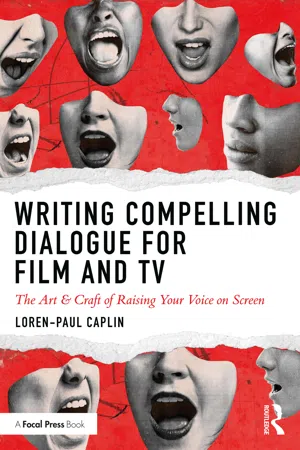
Writing Compelling Dialogue for Film and TV
The Art & Craft of Raising Your Voice on Screen
- 192 pages
- English
- ePUB (mobile friendly)
- Available on iOS & Android
Writing Compelling Dialogue for Film and TV
The Art & Craft of Raising Your Voice on Screen
About this book
Writing Compelling Dialogue for Film and TV is a practical guide that provides you, the screenwriter, with a clear set of exercises, tools, and methods to raise your ability to hear and discern conversation at a more complex level, in turn allowing you to create better, more nuanced, complex and compelling dialogue.
The process of understanding dialogue writing begins with increasing writers' awareness of what they hear. This book provides writers with an assortment of dialogue and language tools, techniques, and exercises and teaches them how to perceive and understand the function, intent and thematic/psychological elements that dialogue can convey about character, tone, and story. Text, subtext, voice, conflict, exposition, rhythm and style are among the many aspects covered. This book reminds us of the sheer joy of great dialogue and will change and enhance the way writers hear, listen to, and write dialogue, and along the way aid the writers' confidence in their own voice allowing them to become more proficient writers of dialogue.
Written by veteran screenwriter, playwright, and screenwriting professor Loren-Paul Caplin, Writing Compelling Dialogue is an invaluable writing tool for any aspiring screenwriter who wants to improve their ability to write dialogue for film and television, as well as students, professionals, and educators.
Frequently asked questions
- Essential is ideal for learners and professionals who enjoy exploring a wide range of subjects. Access the Essential Library with 800,000+ trusted titles and best-sellers across business, personal growth, and the humanities. Includes unlimited reading time and Standard Read Aloud voice.
- Complete: Perfect for advanced learners and researchers needing full, unrestricted access. Unlock 1.4M+ books across hundreds of subjects, including academic and specialized titles. The Complete Plan also includes advanced features like Premium Read Aloud and Research Assistant.
Please note we cannot support devices running on iOS 13 and Android 7 or earlier. Learn more about using the app.
Information
Part One
On dialogue
1
Understanding dialogue
- Introduction: Understanding dialogue
- Function and purpose
- Defining better dialogue
- Tone
- Text and subtext
- Voice
- Conflict
- Exposition
- Style
Introduction: Understanding dialogue
Function and purpose
Table of contents
- Cover
- Half-Title
- Title
- Copyright
- Contents
- Acknowledgments
- Fade in: Introduction
- PART ONE On dialogue
- PART TWO Tool kits for improving your dialogue
- PART THREE Exercises for better hearing and voicing your characters
- Fade out: Conclusion
- Index